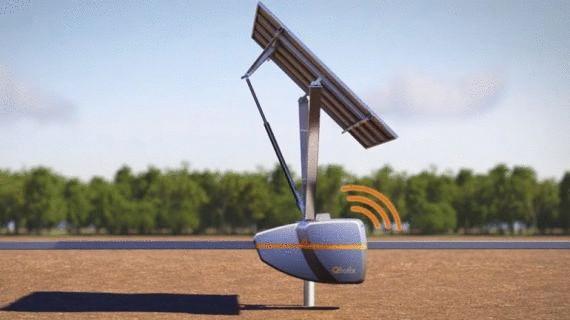475
QBotix robot which adjusts a position of solar panels
The importance of accurate alignment of photovoltaic panels in the Sun no one is questioning. The correct focus of the panel, the more solar energy it can capture and convert into electricity. However, the additional hardware significantly increases the cost of the system. As a result, with all the positive aspects, most panels are installed firmly, losing some of its potential.
The solution offers the market a California startup QBotix. The company developed robotic system, the cost of which is much lower than rotary systems with potentially higher reliability.
QBotix idea is to replace the individual adjusting motors and a combined control system with solar panels by a mobile robot, alternately approaching each panel, correcting her position.

The panels are mounted on a standard turret, equipped with mechanics to uniaxial or biaxial orientation. All elements are positioned near a monorail track on which moves the robot. He in turn goes to every solar system object connects your Electromechanical actuator and adjusts the position depending on where the Sun is. When the robot goes to the next element of the system, circling all of them around during the working cycle.
According to the Executive Director QBotix and doctor of physics at the Massachusetts Institute of technology Vasica Bokhari (Bokhari Wasiq), a large part of the cost of turning solar power systems have on steel. Mobile robots reduce usage by about half.
The use of robots increases the cost of a watt of solar electricity for a few cents, however, significantly reduces initial construction costs and increases efficiency of the whole system. Cost biaxial system robot QBotix is comparable with ordinary uniaxial systems, but plants produce almost 40% more.
QBotix offers for sale a system output of 300 kilowatts, including the robot, redundant robot, monorail and stands tracking. The robots are powered by lithium-ion batteries, their position is tracked via GPS, and data exchange is organized via the wireless network. Each robot can adjust 200 solar panels in a 40 minute cycle, while the value of daily intake of energy is around 30 cents.
Conclusion startup of the first commercial transaction it is planned in October this year. To date, the company has attracted investment of $7.5 million Among the investors of the project are known the Corporation such as Siemens.
Source: /users/104
The solution offers the market a California startup QBotix. The company developed robotic system, the cost of which is much lower than rotary systems with potentially higher reliability.
QBotix idea is to replace the individual adjusting motors and a combined control system with solar panels by a mobile robot, alternately approaching each panel, correcting her position.

The panels are mounted on a standard turret, equipped with mechanics to uniaxial or biaxial orientation. All elements are positioned near a monorail track on which moves the robot. He in turn goes to every solar system object connects your Electromechanical actuator and adjusts the position depending on where the Sun is. When the robot goes to the next element of the system, circling all of them around during the working cycle.
According to the Executive Director QBotix and doctor of physics at the Massachusetts Institute of technology Vasica Bokhari (Bokhari Wasiq), a large part of the cost of turning solar power systems have on steel. Mobile robots reduce usage by about half.
The use of robots increases the cost of a watt of solar electricity for a few cents, however, significantly reduces initial construction costs and increases efficiency of the whole system. Cost biaxial system robot QBotix is comparable with ordinary uniaxial systems, but plants produce almost 40% more.
QBotix offers for sale a system output of 300 kilowatts, including the robot, redundant robot, monorail and stands tracking. The robots are powered by lithium-ion batteries, their position is tracked via GPS, and data exchange is organized via the wireless network. Each robot can adjust 200 solar panels in a 40 minute cycle, while the value of daily intake of energy is around 30 cents.
Conclusion startup of the first commercial transaction it is planned in October this year. To date, the company has attracted investment of $7.5 million Among the investors of the project are known the Corporation such as Siemens.
Source: /users/104






















